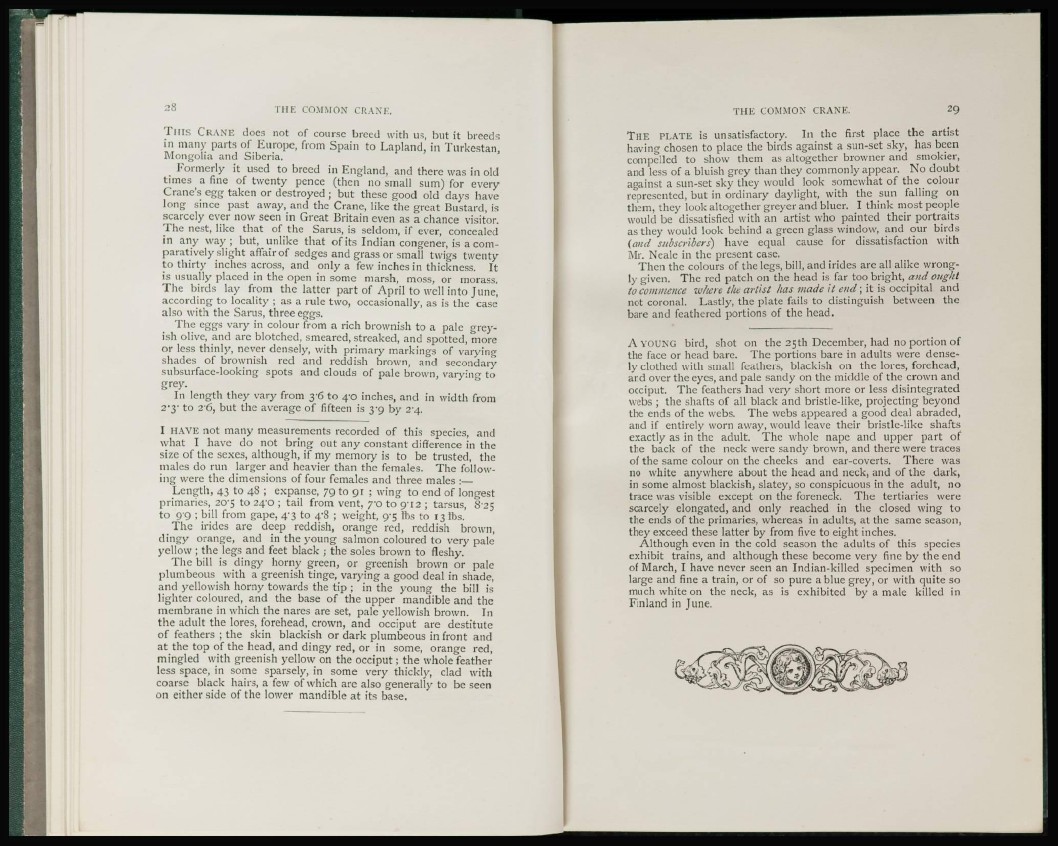
T H I S CRANE docs not of course breed with us, but it breeds
in many parts of Europe, from Spain to Lapland, in Turkestan,
Mongolia and Siberia.
Formerly it used to breed in England, and there was in old
times a fine of twenty pence (then no small sum) for every
Crane's egg taken or destroyed ; but these good old days have
long since past away, and the Crane, like the great Bustard, is
scarcely ever now seen in Great Britain even as a chance visitor.
The nest, like that of the Sarus, is seldom, if ever, concealed
in any way; but, unlike that of its Indian congener, is a comparatively
slight affair of sedges and grass or small twigs twenty
to thirty inches across, and only a few inches in thickness. It
is usually placed in the open in some marsh, moss, or morass.
The birds lay from the latter part of April to well into June,
according to locality ; as a rule two, occasionally, as is the case
also with the Sarus, three eggs.
The eggs vary in colour from a rich brownish to a pale greyish
olive, and are blotched, smeared, streaked, and spotted, more
or less thinly, never densely, with primary markings of varying
shades of brownish red and reddish brown, and secondary
subsurface-looking spots and clouds of pale brown, varying to
grey.
In length they vary from 3 6 to 4/0 inches, and in width from
2 ' 3 - to 2(5, but the average of fifteen is yg by 2'4.
I HAVE not many measurements recorded of this species, and
what I have do not bring out any constant difference in the
size of the sexes, although, if my memory is to be trusted, the
males do run larger and heavier than the females. The following
were the dimensions of four females and three males :—•
Length, 4 3 to 4 8 ; expanse, 7 9 to 9 1 ; wing to end of longest
primaries, 2 0 5 to 24X3 ; tail from vent, 7'0 to 9 T 2 ; tarsus, 8'25
to 9 9 ; bill from gape, 4*3 to 4 ' 8 ; weight, 9 '5 lbs to 13 lbs.
The irides are deep reddish, orange red, reddish brown,
dingy orange, and in the young salmon coloured to very pale
yellow ; the legs and feet black ; the soles brown to fleshy.
The bill is dingy horny green, or greenish brown or pale
plumbeous with a greenish tinge, varying a good deal in shade,
and yellowish horny towards the tip ; in the young the bill is
lighter coloured, and the base of the upper mandible and the
membrane in which the nares are set, pale yellowish brown. In
the adult the lores, forehead, crown, and occiput are destitute
of feathers ; the skin blackish or dark plumbeous in front and
at the top of the head, and dingy red, or in some, orange red,
mingled with greenish yellow on the occiput; the whole feather
less space, in some sparsely, in some very thickly, clad with
coarse black hairs, a few of which are also generally to be seen
on either side of the lower mandible at its base.
THE PLATE is unsatisfactory. In the first place the artist
having chosen to place the birds against a sun-set sky, has been
compelled to show them as altogether browner and smokier,
and less of a bluish grey than they commonly appear. No doubt
against a sun-set sky they would look somewhat of the colour
represented, but in ordinary daylight, with the sun falling on
them, they look altogether greyer and bluer. I think most people
would be dissatisfied with an artist who painted their portraits
as they would look behind a green glass window, and our birds
(and subscribers) have equal cause for dissatisfaction with
Mr. Neale in the present case.
Then the colours of the legs, bill, and irides are all alike wrongly
given. The red patch on the head is far too bright, and ought
to commence zvliere the artist has made it end; it is occipital and
not coronal. Lastly, the plate fails to distinguish between the
bare and feathered portions of the head.
A YOUNG bird, shot on the 25TH December, had no portion of
the face or head bare. The portions bare in adults were densely
clothed with small feathers, blackish on the lores, forehead,
and over the eyes, and pale sandy on the middle of the crown and
occiput. The feathers had very short more or less disintegrated
webs ; the shafts of all black and bristle-like, projecting beyond
the ends of the webs. The webs appeared a good deal abraded,
and if entirely worn away, would leave their bristle-like shafts
exactly as in the adult. The whole nape and upper part of
the back of the neck were sandy brown, and there were traces
of the same colour on the cheeks and ear-coverts. There was
no white anywhere about the head and neck, and of the dark,
in some almost blackish, slatey, so conspicuous in the adult, no
trace was visible except on the foreneck. The tertiaries were
scarcely elongated, and only reached in the closed wing to
the ends of the primaries, whereas in adults, at the same season,
they exceed these latter by from five to eight inches.
Although even in the cold season the adults of this species
exhibit trains, and although these become very fine by the end
of March, I have never seen an Indian-killed specimen with so
large and fine a train, or of so pure a blue grey, or with quite so
much white on the neck, as is exhibited by a male killed in
Finland in June.